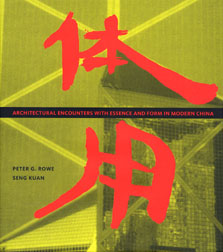Architectural Encounters with Essence and Form in Modern China
 This book is about the episodes around which traditional and modernist attitudes towards architecture in China have been shaped, co-mingled and reshaped, since the opening of the Treaty Ports in the 1840s. The text opens and is sustained by snatches of discussion overheard in a design studio, somewhere in Beijing, during the course of a day, about a project under construction. As the three young designers struggle with their deliberations, arguments ensue and issues are raised, which are then taken up, expanded and elaborated upon in the segments which follow. Central to the discussion are the concepts of ti and yong,or ‘essence’ and ‘form,’ two Chinese characters that are used to define the proper arrangement of what should be considered modern and what should be thought of as essentially Chinese, during various episodes of architectural debate and production. First spoken of in terms of ‘Chinese learning for essential principles, and Western learning for practical functions,’ during the Self-Strenghtening Movement of the nineteenth century, the alignment of the ti and yong has gone through various transformations, including ‘socialist content,’ or essence, and ‘cultural form,’ to an almost complete reversal, in contemporary times, of ‘modern content’ ameliorated through ‘Chinese form.’
This book is about the episodes around which traditional and modernist attitudes towards architecture in China have been shaped, co-mingled and reshaped, since the opening of the Treaty Ports in the 1840s. The text opens and is sustained by snatches of discussion overheard in a design studio, somewhere in Beijing, during the course of a day, about a project under construction. As the three young designers struggle with their deliberations, arguments ensue and issues are raised, which are then taken up, expanded and elaborated upon in the segments which follow. Central to the discussion are the concepts of ti and yong,or ‘essence’ and ‘form,’ two Chinese characters that are used to define the proper arrangement of what should be considered modern and what should be thought of as essentially Chinese, during various episodes of architectural debate and production. First spoken of in terms of ‘Chinese learning for essential principles, and Western learning for practical functions,’ during the Self-Strenghtening Movement of the nineteenth century, the alignment of the ti and yong has gone through various transformations, including ‘socialist content,’ or essence, and ‘cultural form,’ to an almost complete reversal, in contemporary times, of ‘modern content’ ameliorated through ‘Chinese form.’
In all, there are eight parts to this story. The first concerns cultural developments in China in response to the forced opening to the west in the mid-nineteenth century, and the moments that followed, in efforts to reform the Qing dynasty and to define the successive cultural outlooks of the Nationalist and Community regimes. The second is about the architecture, which began with foreign influences and the return of the first generation of overseas-trained Chinese architects. The third concerns four rather distinct architectural orientations towards tradition and modernity, or ti and yong, that occurred primarily during the formative decades of the 1920s and 30s in China, when modernism was first introduced. The fourth is about the controversy over the use of ‘big roofs’ and other sinifying aspects of Chinese architecture, which took place in the 1950s, culminating in the tenth-anniversary projects of the Communist government in 1959. The fifth takes place during the hard economic times of the ‘Great Leap Forward’ and the ‘Cultural Revolution,’ when architecture was almost abandoned, as building became more and more reduced in scope. The sixth deals with the beginning of reform and the opening up to the outside world in the late 1970s and 80s, a period of cultural revival, experimentation and ‘catch-up’ with the Western world that was brought temporarily to a halt in Tianamen Square in 1989. The seventh concerns the present period of the socialist market economy, when China embarked upon freewheeling architectural production, at times in a seemingly indiscriminate manner, before coming to grips with matters of architectural expression more systematically and knowingly. Finally, the eighth segment offers commentary on what appears to have occurred in architecture during the still incomplete process of modernization in China, and a prognosis for the future.
Throughout, the book is well illustrated and accompanied by first-hand accounts of the buildings described, as well as incorporating basic historical narrative, in order to help better situate readers at various important moments along the way. A profile of major modern Chinese architects and educational institutions is also provided, as an appendix, along with an extensive glossary of terms and proper names, in an effort to interpolate between English and Chinese.
MIT Press